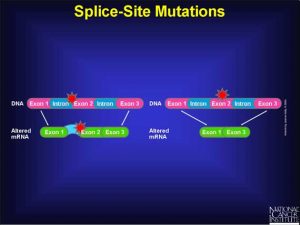Regarding mutation and disease, DNA has always been subject to mutations and accidental changes in its code and thus may lead to missing or malformed proteins, and finally cause serious illnesses.
Humans may have started out their lives with different kinds of mutation and disease. Mutational changes can be conveniently classified into two sorts: those that appear to involve single genes and are generally referred to as gene mutations, and those that involve chromosomal segments containing many genes, or even whole chromosomes, and are called chromosomal mutations. Both of these kinds of mutations occur in germ-cell lineages and contribute considerably to inherited disease, or pre-disposition to disease. Furthermore, both mutations occur in somatic cells and contribute to acquired disease. However, those mutations inherited from parents are named germ-line mutations. Also, you can acquire mutations during your lifetime. Some mutations happen during cell division, when DNA gets duplicated. Still other mutations are created when DNA gets damaged by environmental factors, including UV radiation, chemicals, and viruses.
What type of error can occur?
The most common type of error to occur is when a single base is substituted for another. Occasionally, a base may be deleted, or an extra base may be added or changed. Regardless of the error, most cells usually repair any accidental changes, but errors that are not corrected in cells that become an egg or sperm will be passed on to any offspring.
The DNA sequence of a gene can be changed in several different ways, including:
Missense mutation
One base pair is changed and the type of amino acid that is produced is different.

Nonsense mutation
One base pair is changed which causes the cell to stop building a protein where the error has occurred. This results in a shortened protein that may not function correctly, if at all.
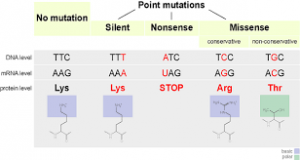
Insertion
When one or more bases are added into a region of DNA.
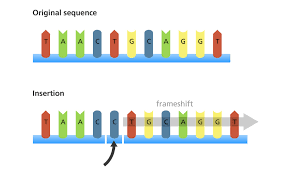
Deletion
One or more bases may be removed from a sequence of DNA.
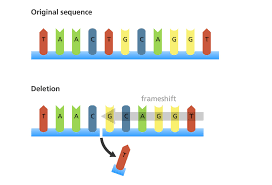
Frameshift
Each strand of DNA is made of sequences of bases which are “read” in groups of threes, called codons. Each codon produces one amino acid. The deletion or addition of one or more DNA bases can change the way in which a gene is “read”, shifting the reading frame along and resulting in a faulty protein.
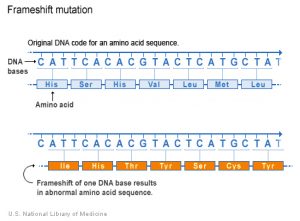
Point
Just one base is changed in a DNA sequence – this may be silent, missense or nonsense.
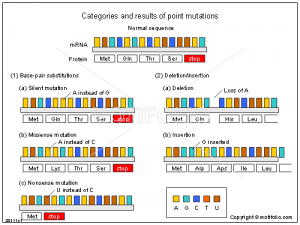
Silent
A change that occurs still produces the same amino acid as before and has no impact on the protein produced.

Splice site
A change to a number of bases that causes a gene to be incorrectly copied into mRNA during transcription.
Chromosomal translocation
Part of a chromosome that reattaches in the wrong place.
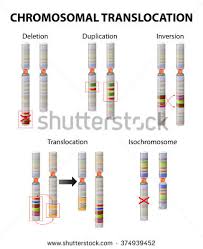
Is a mutation always bad?
Not all sections of DNA code for a gene. Actually, most changes to DNA often occur in the vast areas of DNA between genes, and so have no effect. Changes to areas that code for genes can sometimes mean that proteins are not made correctly and instead are produced in the wrong quantitates or not made at all. When a mutation does occur in the areas which produce proteins, it is probable to simply cause a different version of the gene resulting in a different characteristic, which is neither good nor bad (i.e. different hair color or ear length). It is unusual for these changes to be serious or result in death or disease, but it can occur.
Thus, a few of different kinds of mutations are bad for you and some mutations can be beneficial. Over time, genetic mutations create genetic diversity, which keeps populations healthy. Many mutations have no effect at all. These are called silent mutations.
Mutations that cause disease: Most of the mutations are the ones that cause disease. Some well-known inherited genetic disorders include cystic fibrosis, sickle cell anemia, Tay-Sachs disease, phenylketonuria and color-blindness, among many others. All of these disorders are caused by the mutation of a single gene.
Moreover, most of inherited genetic diseases are recessive, which means that a person must inherit two copies of the mutated gene to inherit a disorder. This is one of the reasons that marriage between close relatives is discouraged; two genetically similar adults are more likely to give a child two copies of a defective gene.
On the other hand, diseases caused by just one copy of a defective gene, such as Huntington’s disease, are rare. Thanks to natural selection, these dominant genetic diseases tend to get weeded out of populations over time, because afflicted carriers are more likely to die before reproducing.
According to scientists’ estimations, every individual has between 5 and 10 potentially deadly mutations in his genes-the good news is that because there’s usually only one copy of the bad gene, these diseases don’t manifest.
Cancer as one of the serious diseases usually results from a series of mutations within a single cell. Often, a faulty, damaged, or missing p53 gene is to blame. The p53 gene makes a protein that stops mutated cells from dividing. Without this protein, cells divide unchecked and become tumors.
The effect of age on mutation
Aging is thus associated with increase in mutations in normal tissues and an increased risk of diseases like cancer, possibly in part because of an age. Due to their extremely low abundance, somatic mutations in normal tissues frequently escape detection. Tumors, as clonal expansions of single cells, can provide information about the somatic mutations present in these cells prior to tumorigenesis.
How can we account for a higher mutation rate in males than in females? The most obvious explanation lies in the much greater number of cell divisions in the male germ line than in the female germ line. In the female the germ cell divisions stop by the time of birth and meiosis is completed only when an egg matures. In the male, cell divisions are continuous and many divisions have occurred before a sperm is produced. If mutation is associated with cell division, as if mutations were replication errors, we should expect a much higher mutation rate in males than in females. This makes the strong prediction that the mutation rate should increase with the age of the father, since the older the man, the more cell divisions have occurred. On the other hand, there should be no age effect in females.
Other Causes of Mutation and disease
Furthermore, studies in experimental animals demonstrate that exposure to physical or chemical mutagens increase the incidence of inherited gene and chromosomal mutations. Though, such increases have not been unequivocally demonstrated in human populations exposed to known mutagens, studies on mutation in human lymphoid or epithelial somatic cells clearly show an increased frequency in cells taken from people exposed to ionizing radiations or chemical mutagens or in cells exposed in vitro. The consequences of such mutations will depend upon their nature and the origins and functions of the cells in which they occur. Of particular importance are mutations influencing cell growth and proliferation, and both gene and chromosomal mutations are implicated as causal factors in the development of human cancers.

